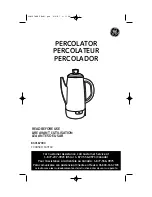
2
Getting Acquainted
Your canner is a special, large capacity pressure vessel designed for
home canning a wide variety of fruits, vegetables, meats, poultry,
fish, and seafood. The canner uses pressure to achieve the high
temperatures required for safely processing foods while canning.
The United States Department of Agriculture (USDA) recommends
the pressure canner as the only safe method for canning low-acid
foods: vegetables, meats, poultry, fish, and seafood.
Become familiar with the various parts of the canner (Fig. A).
Do not attempt to use your pressure canner before reading the
instructions on pages 4 and 5.
Introduction to Parts
Note: The parts shown are not to scale.
Pressure Regulator
The pressure regulator controls and maintains the correct pressure in the canner. It can be
adjusted to maintain 5, 10, or 15 pounds of pressure. When it is rocking gently, the selected
pressure has been reached.
Completely assembled, the regulator will maintain 15 pounds of pressure. When one ring
is removed, it will maintain 10 pounds of pressure. When both rings are removed, it will
maintain 5 pounds of pressure. To adjust it, remove one or both of the 5-pound weight rings
from the regulator body.
To remove the weight rings, hold the completely assembled regulator between the first two fingers of
your hand; your thumb should be on top of the knob. Press the knob down to force the weight rings
over the lock ring on the regulator body. To replace the weight rings, place them over the knob and
push them down over the lock ring at the top of the regulator body.
Vent Pipe
The vent pipe is the primary pressure relief valve and will release pressure in excess of the desired
pressure. The pressure regulator sits loosely on the vent pipe. The replacement vent pipe (
A) has a
different look but still functions the same way as the original one for your canner.
Air Vent/Cover Lock
The air vent/cover lock automatically vents, or exhausts, air from the canner and acts as a visual indication of
pressure in the canner. The small gasket (
A) must be in place for the air vent/cover lock to seal completely.
Locking Bracket
The locking bracket on the inside of the canner body engages with the air vent/cover lock to prevent the cover from
being opened when there is pressure in the unit.
Overpressure Plug
The black, rubber overpressure plug is located in the canner cover. It will automatically pop out and
release steam in case the vent pipe becomes blocked and pressure cannot be released normally. Replace the
overpressure plug every time you replace the sealing ring. This should be at least every 3 years, or sooner if
they become hard or inflexible. Use only genuine Presto
®
replacement parts.
Sealing Ring
The sealing ring fits into the canner cover and forms a pressure-tight seal between the cover and the body
during canning. Replace the sealing ring at least every 3 years. Use only genuine Presto
®
replacement parts.
Canning Rack
The rack is placed in the bottom of the pressure canner to hold the jars off the bottom of the canner while
canning. Always use the rack as the jars may break if set directly on the bottom of the canner.
A
Fig. A
(in cover and
not shown)
15 pounds
of pressure
10 pounds
of pressure
5 pounds
of pressure
A



































